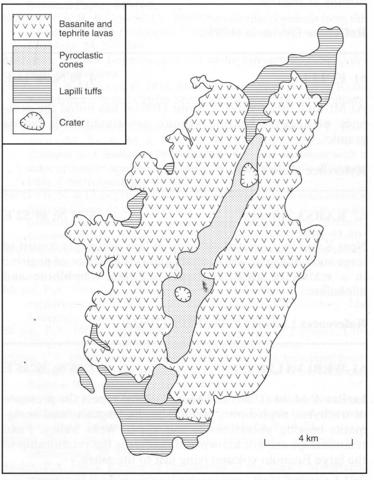stripes
The Korath Range is an isolated group of volcanic hills lying within the rift some 60 km north of Lake Turkana. The range comprises about 20 aligned and coalescing tuff cones flanked by lava flows (Brown and Carmichael, 1969). The lavas issued from the lower flanks of the cones except for one which erupted from the centre of one of the craters and flowed through the breached rim. The flows are blocky, up to 5 km in length, may exceed 8 m in thickness and were often preceded by eruption of tuffs rich in crystals of olivine, pyroxene and amphibole. Two types of lava are distinguished: basanite and tephrite. The basanites contain phenocrysts of olivine, Ti-augite and rare plagioclase in a groundmass of calcic plagioclase, poikilitic patches and tiny interstitial grains of nepheline, leucite, confined to interstices, phlogopite, Fe-Ti oxides, apatite and glass. The pyroxene and plagioclase of the tephrites is similar to that of the basanites but olivine is absent. Kaersutite forms phenocrysts up to 3 cm in length with reaction rims of iron oxides; nepheline and leucite may occur as groundmass phases together with phlogopite, apatite and glass. Analyses of olivine, pyroxene, nepheline, leucite, kaersutite and phlogopite are given by Brown and Carmichael (1969) who also present rock analyses and discuss at length the petrogenesis of the lavas.
BROWN, F.H. and CARMICHAEL, I.S.E. 1969. Quaternary volcanoes of the Lake Rudolf region: 1. The basanite-tephrite series of the Korath Range. Lithos, 2: 239-60.

